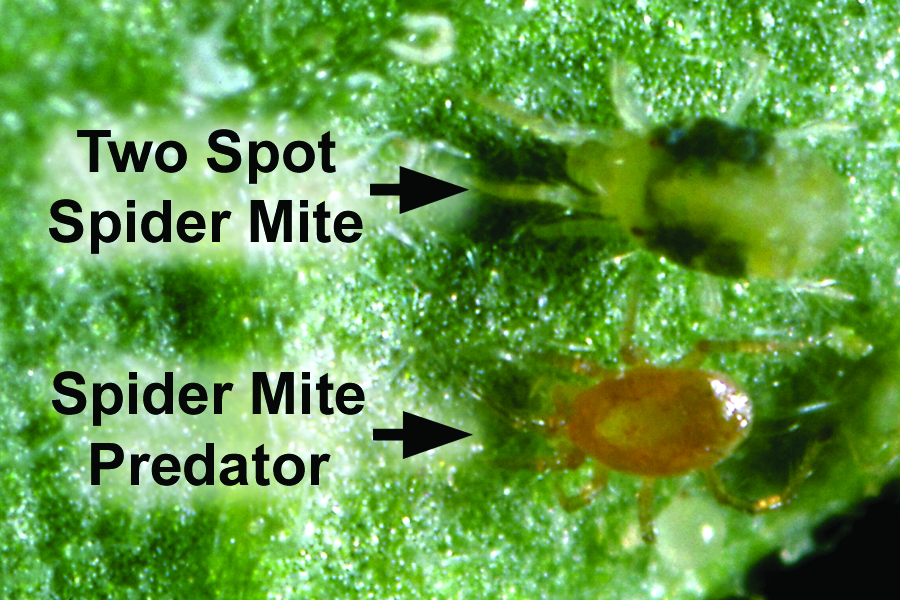
The first signs this pest has arrived are yellow speckling on leaf surface. Eventually little dots on underside of leaves and fine webbing between leaves. Under magnification small eggs shaped like perfect spheres might be visible and you plants may also lack vigor.
Spider Mites are probably the most well-known and common cannabis pest in existence. Most growers have encountered them at one time or another and some growers are plagued with them crop after crop. They are tiny little pests, but can be very destructive. They suck vital juices from the plants using mouth parts which have been modified to pierce the individual plant cells. As spider mites feed on the plant, they destroy the chloroplasts in the leaves. This leads to a decline in photosynthesis, the stomatas close and transpiration decreases. If left uncontrolled the plant will continue to weaken and eventually die.
Spider Mites usually live on the underside of the leaves. They are very small, less than 0.04 inches across or about the size of a pinhead. They have a clear to yellow color and as they grow older they get two dark spots on their back. The dark spots grow larger as they feed on more chlorophyll and plant juices. Spider Mite eggs look like perfectly clear or amber round spheres when viewed with a magnifier. As the spider mites become more established fine webbing can be found stretching between leaves and covering the tops and buds of the plant.
Environmental conditions greatly influence the Spider Mite life cycle and they thrive in hot, dry conditions. As the temperature increases, they can evaporate more moisture from their body and in turn suck more juices from the plant. In temperatures above 100 degrees, their life cycle can shorten from 3 weeks down to as little as 1 week from egg to adult! They can become sexually mature in 5 days with each female living up to 4 weeks and being capable of laying 20 eggs per day. As those eggs hatch and the resulting mites start breeding the entire population can explode very quickly. This is why some growers will see a couple of Spider Mites and then a week or two later their plants are covered in webs.
Outdoor cannabis growers need to be aware of the Spider Mites ability to go dormant. When light hours outdoors start to drop below 12 or 13 hours per day and at the same time temperatures start to drop, Spider Mites can enter a “diapause” state. Adult females discontinue feeding, mating and other normal activities, and turn almost completely red in color. They search for a safe place to spend the winter. These safe places can be a crevice in a tree trunk, plant debris, or even grow equipment. They will stay in a dormant state until the next spring, and as the temperature warms back up they emerge to infest your new plants.
One of the best ways to control mites is to take measures to prevent them from getting established on your cannabis plants. Spider Mites are very creative when it comes to finding their way onto your crop. They can hitch a ride on a strong breeze, literally blowing in the wind onto your plants. They can also climb onto people and pets, so if you have visited other cultivation sites make sure you change your clothes and take a shower before entering your garden. Vigorously inspect and quarantine any new plants before you put them near the rest of your crop.
There are dozens of sprays and miticides on the market that can kill Spider Mites, but after decades of use their effectiveness has diminished – and besides, who wants to smoke pesticide! Many legal states have very strict testing requirements for pesticide residue. Here in Oregon changes to testing limits mid-season has effectively shut down many large growing operations. One way to be sure you will not fail any test is to use natural predators that eat Spider Mites instead of sprays.

Spider Mite Predators are the most common and widely used insect to control Spider Mites. In most conditions they will reproduce faster than the Spider Mites. Each Spider Mite Predator sucks the juice out of about 5 Spider Mites a day, or 20 of their eggs. Three of the more common species used are Phytoseiulus persimilis, Mesoseiulus longipes, and Neoseiulus californicus. These small mites love to eat Spider Mites and their eggs. For cannabis we recommend 1 predator for every 5 to 10 Spider Mite adults and eggs. To estimate your Spider Mite population you can count the Spider Mite adults and eggs on an average leaf. Count how many leaves you have on the plant and multiply the two numbers together. This will give you a rough estimate of how many Spider Mites you have on one plant. Then multiply that by the number of infested plants to get an idea of how large your total population is and how many predators you might need to control it.
Amblyseius andersoni and Amblyseius fallacis can eat both Spider Mites and Russet Mites, so they are a great choice if you are dealing with both pests at the same time. Specially constructed hanging sachets full of predators are now available with some species of predators. These sachets usually hold a few hundred predators which will reproduce inside the container, slowly releasing for 2 to 4 weeks. This is a great option for prevention, and I recommend a few sachets of predators such as A. andersoni on every plant. Other predators are available in tubes filled with a media such as corn cob grit. These are applied directly to the leaves and are immediately available to attack Spider Mites, making them an excellent option when dealing if you are dealing with an active outbreak. If your plants have well developed flowers, be careful not to get the media on the flowers as it can be hard to remove and is undesirable on the finished buds. In these situations, fill small plastic containers (like 1 oz. ketchup containers) and place them strategically throughout the plant. You can also sprinkle some predator filled media onto index cards and place them in the foliage. After a few days these can be removed and discarded.
Spider Mite Destroyers Stethorus punctillum are a larger mite predator related to the ladybug. They can be used in conjunction with other mite predators when Spider Mites have been difficult to control. Stethorus eat all stages of Spider Mites and can fly from one infected plant to the next. They take longer to reproduce, but can eat an astonishing 40 Spider Mites every day! Female Stethorus can lay up to 15 eggs per day. The life cycle from egg to adult takes 18 days at 70 degrees F, and is even faster at warmer temperatures.
Green Lacewings, Pirate Bugs and Ladybugs are general feeders that eat many small soft-bodied insects including Spider Mites. They are good predators to use for prevention, and also great to use if you have more than one species of pest to deal with. They are not specific to Spider Mites like some of the predators are, but their ability to eat other insect pests and live longer without a source of food can be desirable.
Nearly all cannabis growers eventually get Spider Mites. They can be a very destructive pest and need to be dealt with as soon as they are discovered. It is important to regularly inspect your plants for Spider Mites and other pests. Use preventative measures whenever possible and keep a healthy population of beneficial insects established on your plants before you have a serious outbreak.
Nathan Jackson is the owner of Nature’s Control and Ladybug Indoor Gardens. Located in Phoenix, Oregon. Nature’s Control has supplied growers with beneficial insects for over 35 years. He can be reached at 541.245.6033 or nathan@naturescontrol.com.
Related Articles & Free Email Newsletter
The Best and Most Popular Cannabis Fertilizers
The Importance of Silicon in Cannabis Production





Comment here